Indiana Jones and The Emperor's Tomb
Kristan has been humming the tune all day
It's bizarre to recount that the best Indiana Jones game ever made was in fact a point and click adventure; the several half-hearted attempts over the past decade and a half have merely disappointed those looking to LucasArts to come up with a whip cracking adventure worthy of sporting the Man With The Hat's license.
When LucasArts unveiled The Emperor's Tomb to the world at last year's E3, it looked like it had finally cracked it, abandoning its in-house approach and bringing on board The Collective, the team which impressed so much with its Buffy The Vampire Slayer title. With the same engine employed here, hopes were high that not only would we finally be getting a decent Indy action game, but one to finally usurp Lara Croft: arch Raider of all Tomb-related ideas.
The early impressions are all good. Even the most jaded, bored-stiff gamer can't fail to have immense fun in The Emperor's Tomb; with the more laborious trudging and exploration elements of the Tomb Raider series kept to a minimum, sticking instead to a relentlessly entertaining, high octane assault of platforming, Double Dragon-esque fisticuffs, shooting and straightforward puzzle elements. Rather like an Action Adventure equivalent of Medal of Honor: Frontline, the game design takes care to avoid frustration, and keep the player involved. While it's fair to perceive this as 'funnelling' gamers through your quest, the upsides are plentiful; rarely, if ever, will you find yourself hitting brick walls thanks to sprawling environments or wilfully obscure puzzle solving and object collection/inventory management. Instead, The Collective wants you to engage in the gaming equivalent of a thrill ride, treating the gamer to one exhilarating set piece after another.

A feasible reason to travel the world raiding tombs? Why, of course.
Set in 1935, just before The Temple Of Doom, Dr. Jones finds himself on a quest to retrieve the three pieces of the Dragon Seal, to allow access to the crypt of China's first emperor. And why? Because inside lies the legendary Heart Of The Dragon - one of the most powerful artefacts known to man, offering its possessor the power to mould the human mind. Creepy.
From the moment the game kicks off, you're thrust into a lavish environment filled with the sights and sounds of the Indiana Jones movies. The Ceylon levels strike the right chord immediately, with spectacular views, lush foliage, and skeleton-strewn temples. Not only does Indiana Jones look spookily like Harrison Ford himself, but the voice acting is astonishingly spot on. Add to that the presence of the requisite John Williams score (in 5.1 surround, too), and this is as good an example of interactive merchandising as we've seen. Every location seems to have been lovingly polished, with tons of incidental touches that add greatly to the atmosphere; flocks of birds flapping off into the distance, the squeaking rats that scurry around the deserted temples, and the stunning waterfalls to name but a few.
Moving through the game, the quality level never lets up; the Prague levels are architecturally exquisite, while the Istanbul, Hong Kong and Pen Lai levels are similarly replete with deft touches, artistic flair, and most importantly atmosphere. The only slight annoyance is the occasional clipping issue, with enemies sometimes sinking into the scenery, and the odd seam noticeable. Also, while the detail level is consistently high, there is a regretful absence of bump-mapping and dynamic lighting; possibly a legacy of its multi-format development birth. Put it this way; it's not going to trouble Splinter Cell or Halo in the visual stakes, but The Collective make up for it in other ways.
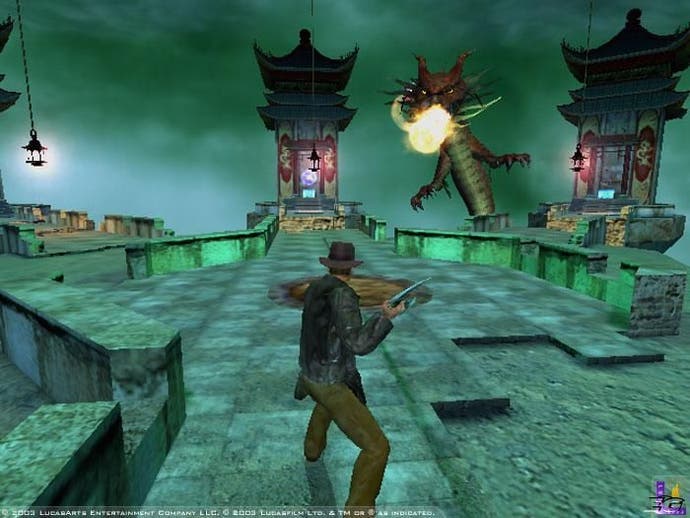
A punch up the bracket
As we've touched upon already, the combat is possibly the area you'll enjoy most in The Emperor's Tomb. Indy loves a good punch-up, and boy, can this fellow scrap. Using X and A or both, you can deal more pugilistic carnage than an ear-hungry Mike Tyson, delivering a succession of superbly satisfying manoeuvres, from swift one-twos to grab-and-hurl combos, depending on where you enemies are at any given point. But as well as being very handy in unarmed combat, Indy can also make use of just about anything left lying around (Y to pick up), including chairs, liquor bottles, knives, and, of course, a whole selection of guns.
For the first few hours enemies can seem little more than cannon fodder, just standing around politely waiting for their turn to die, but once you acknowledge that the game's first ten or so levels are nothing more than an extended tutorial to ease you into the action, things start to improve greatly. In general the combat is well balanced, with just the right amount of ammo left to go around. If you're a bit trigger happy, though, you can always rely on Indy's unarmed skills, as a few well placed blows can knock the enemy's weapon clean out of their hands - which both you and your foe can pick up to their advantage. Often it pays to save your ammo for when you really need it, as fistfights generally go the distance before they finally keel over with a groan. With bullets in such short supply it pays to aim carefully, which you can either leave up to the game's auto-targeting, or perform manually; hitting the left trigger to switch into a first person view, complete with crosshair, and firing off a head shot or two.
As a last resort, you can always get your trusty whip out and pull off some hilariously over the top moves; lassoing your foe towards you and biffing them in the chops, before cracking them repeatedly. It can take an age to knock a foe unconscious this way, but it's worth it almost for the comedy value alone. Stealth also plays a part in combat, and walking silently up to enemies allows you to pistol whip them to the ground, allowing you to throw a few well-placed kicks to the groin while they're on the deck.
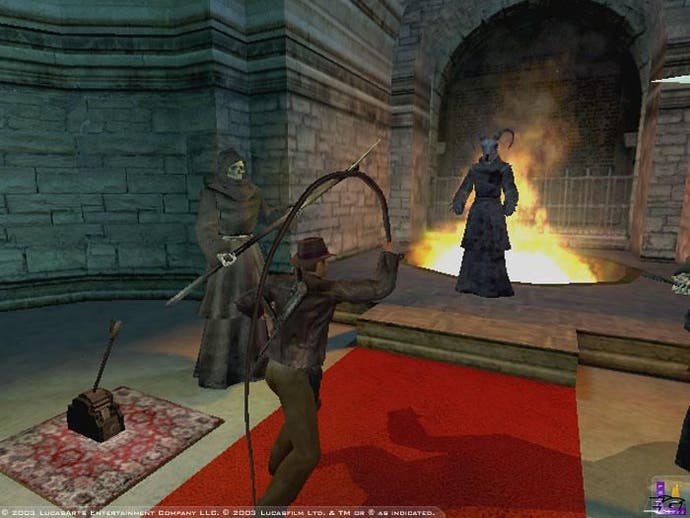
Toys? We like toys
As with all the best action games, rewards are well placed, with every new game area giving you a greater variety of toys to play with, which is just as well, as the enemies soon come thicker, faster and better armed. Taking care is all-important in The Emperor's Tomb, as the only opportunity to save your progress is to complete a mission. Taking a pounding not only means your hat gets knocked off (sacrilege!), but it could mean Game Over before you know it. You can top up your health with canteens and the odd medicine pack, but trying to pull this off midway through combat is a damned tricky procedure - an unfortunate throwback from Buffy - requiring you to scroll through your inventory with left or right on the D-pad, before selecting the object and - in the case of the canteen - finding a quiet spot to slowly drink your way back to health. It's a lot harder than you imagine, but overall you'd be hard pressed to find a game with a more entertaining combat system. It may not always be realistic, or have the best AI, but in terms of fun it's pretty much unrivalled.
It's just as well the combat system is so strong, as the puzzle elements would barely tax even the lamest brain. If Indy can interact with something, an icon appears to tell you of the fact, informing you that tapping the Y button will bring up the object or the action required. For example, much of the game relies on your use of the whip, and if you're standing near an item Indy can swing across, up the icon pops. Hitting Y, then A will persuade our hero to traverse the gap, although sometimes you'll need to run up and tap B to leap before you can pull off the move.
As you'd expect, there's also a myriad of traps to negotiate along the way. The usual slice and dice implements of death get a look in, as do dart-firing machines, crumbling floorways, sound-sensitive automatons, and a whole pile of evilry. Jumping's a huge part of The Emperor's Tomb, although it's handled far more elegantly than most Action Adventures we can think of. Holding down the right trigger stops Indy from falling to his doom if he's close to an edge, while the jump and catch mechanic is handled dynamically, making your success rate far higher than it would otherwise be. Add in to the mix the odd bit of ledge-shimmying, backs to the way shuffling and swimming, and it's a versatile system that works well, feels convincing and does what you tell it to for the most part.
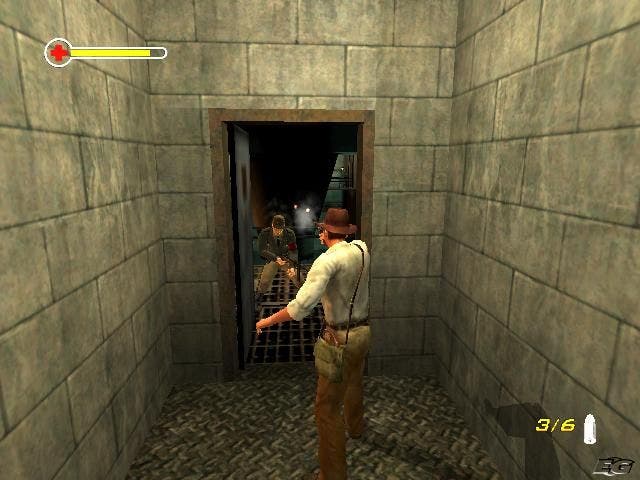
Praise be! A camera that works!
The camera system, too, is worthy of serious praise. Not only do you get to choose whether to invert the X and Y-axis as you see fit (praise be), but even in the tightest situations you're given the best view possible, even to the extent of making Indy transparent if his big bonce is in the way. When so many good games trip up on this, you're grateful when someone gets it right. Developers take note. Please.
And as if that wasn't enough, the audio is truly excellent throughout too. All the familiar themes are present, and add a touch of drama to the proceedings when things kick off, while the grunting, panting Indy lets you know how much pain and suffering you're putting him through. The voice acting is up to LucasArts' usual high standards as well, with all the various characters putting in good performances, from the chatting Nazi guards to the slick cut scenes. Again, other publishers and developers take note; it adds so much to a game to get these basic areas right.
However, although the slick combat, excellent controls, and frustration-less level design keep you entertained, it's still easy to spot the cracks in The Emperor's Tomb. The overriding issue we had with the game is that while it's acceptable to lead the gamer by the hand, The Collective really does seem to have been instructed to go for the lowest common denominator approach of giving the gamer little choice but to succeed.
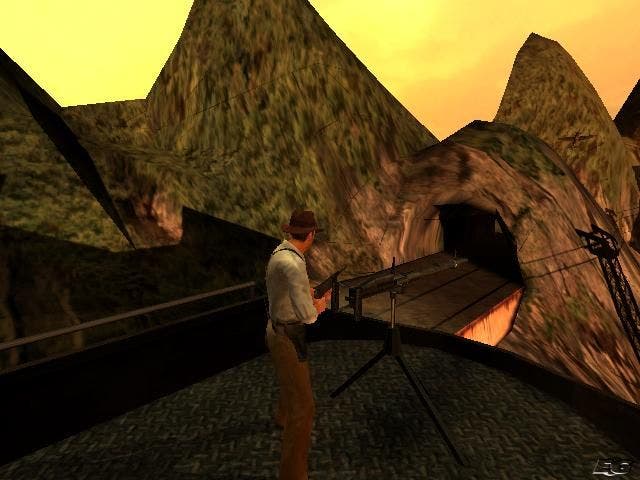
Easy peasy
Now, we don't have a problem with games being built around a succession of small levels - why, some of the best games ever made get by on this very premise - but in Indy's case, not only are they remarkably linear throughout, but the puzzle dynamics are often excruciatingly basic, in a kind of 'my first Action Adventure game' type way. It really does seem like this game was made for 11-year-olds. The level objectives rarely extend beyond killing a few conveniently placed (and mostly stationary) baddies at a time, while on the hunt for painfully obvious levers and switches. While the Tomb Raider series would always require you had an often intimate knowledge of the quite expansive levels, The Emperor's Tomb keeps the gamer consistently confined within very tight locales.
For example, pulling levers will always result in opening a door just feet away from where you are, never giving you any remote possibility of being in doubt - and thus removing any sense of achievement from the gamer. Even the game's later multi-part puzzles and boss monsters won't have anyone but the complete gaming novice stumped, and for many, this approach just makes it feel unsatisfying. And we're sorry to harp on about The Fate Of Atlantis again, but that was a game that knew how to do puzzles. How is it that puzzle-meisters LucasArts can let go of one of areas it was always the industry leader in? Why do publishers seem to be afraid to challenge gamers these days? Gamer are growing older, not younger.
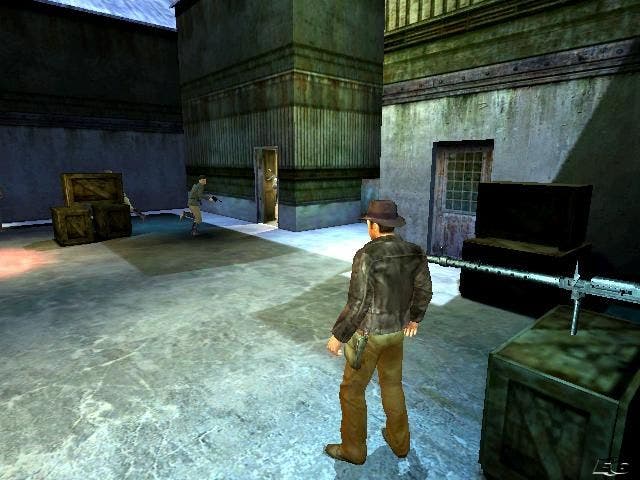
Some AI polish would have been nice, thanks for asking
Combat too has its flaws, thanks to the bizarrely inconsistent AI. While it's entertaining to dispatch groups of enemies with hilarious moves and crunching sound effects, the actions of your foe vary between the sublime and the ridiculous, which smacks of a lack of polish in the final stages of development.
On the one hand, it's genuinely impressive to witness your foes ducking for cover behind walls, popping out to fire off a few rounds at you, as is seeing them picking up your dropped weapon to use against you or lobbing grenades back in your direction. But the amount of times these buffoons stand around in circular groups wobbling around like Teletubbies basically waiting for their turn to cop a bullet in the head is laughable.
Other random AI lameness rears its ugly head from time to time, including that old friend of ours, the 'running into a random bit of scenery' syndrome, or its good buddy, Mr. 'standing without a care in the world just after his mate has been shot in the head'. Passing spectators will on the one hand be gasping in awe at the spectacular action on show, but simultaneously snorting in derision at some very odd behaviour. It's like LucasArts picked up a build of the game a few months back and decided 'yup, that'll do', without fixing some of the outstanding issues, which is a shame when you consider how good it could've been with a little more polish.
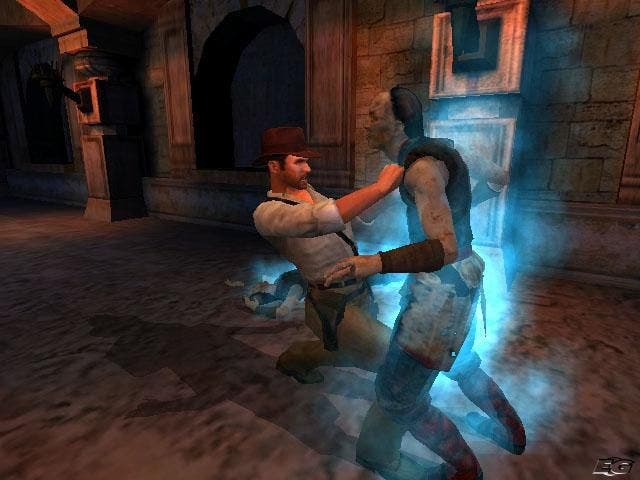
No ticket
One can only hope that somewhere along the line that LucasArts takes on board the criticisms of its latest attempt and goes on to make the benchmark whip-cracking adventure that we all yearn for. But rather like EA's clueless Bond games of recent years, this is a licensed game that has been designed unapologetically for the mass market from the ground up. It'll appeal to the attention-deficient, thrill seeking gamer, but those who expect something a little deeper should be aware of its shortcomings. But as a cohesive, enjoyable action game, The Emperor's Tomb still stands out among film tie-in fodder; it's a blast from start to finish and somehow manages to be greater than the sum of its parts. It's perhaps a classic example of the ideal game to rent; you'll enjoy it while it lasts, complete it over a weekend, and move on.
Indiana Jones and The Emperor's Tomb screenshots (Xbox)
Indiana Jones and The Emperor's Tomb screenshots (PC)
Indiana Jones and The Emperor's Tomb screenshots (PS2)

